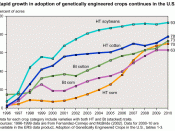Genetically Modified Food
A shrinking number of agrochemical companies are modifying the genetic structure of our food. But they don't want to tell us. In the last thirty years global demand for food has doubled. In a race to feed the planet, scientists have discovered how to manipulate DNA, the blueprint of life, and produce what they claim are stronger, more disease-resistant crops. However, fears that Genetically Modified Food may not be safe for humans or the environment has sparked violent protest. Are we participating in a dangerous global nutritional experiment?
"Scientifically we are on the threshold that we've never crossed before we simply do not have the expertise to judge whether we know what we're doing or not."
Moth genes are being fused with potatoes, Arctic Char genes are being fused with strawberries, flounder genes are being fused with tomatoes, and firefly genes are being fused with corn.
Food is something very existential and something very fundamental to human beings.
Even though people may not understand the complications and workings of GMO's, most people come into doubt when they suspect that they're food is chemically contaminated or genetically modified and the secrecy of the corporations gives boost to that notion. The deal with genetically modified food is this: basically, Corporations, like Syngenta and Monsanto, are putting genes from another species into germ plasm to create characteristics or traits which are more desirable to those companies who are mass producers of corn, soybeans, and most generally, food that goes to cattle that make meat.
Monsanto, one of the corporate giants in this field, engineered soybeans to make them resistant to a specific pesticide called "Roundup" and of course, this pesticide just happens to be sold by Monsanto. The purpose is not to increase the yield of the soybeans; the purpose...


